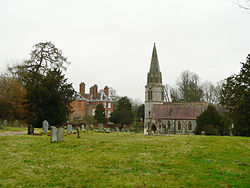Welford Park
| Welford Park | |
| Berkshire | |
|---|---|
 The rear of Welford Park House, with St Gregory's Church | |
| Location | |
| Grid reference: | SU402730 |
| Location: | 51°27’19"N, 1°25’18"W |
| Village: | Welford |
| History | |
| Country house | |
| Information | |
| Owned by: | James Puxley |
Welford Park is a country house and estate in the village of Welford in Berkshire, near the town of Newbury. It extends form the south bank of the River Lambourn and inland, immediately on the west side of Welford.
This is a private house. Whilst of some historical significance, the estate is perhaps best known locally for its displays of snowdrops in early spring.
The church of St Gregory, one of only two existing round-tower churches in Berkshire, stands adjacent to the house. The various chalk streams that make up the River Lambourn flow through the grounds.
History
Welford Park is built on the site of a monastic grange that belonged to Abingdon Abbey from Anglo-Saxon times.[1] After the dissolution of the monasteries, King Henry VIII used the site for a hunting lodge.[1] Later it was granted to Sir Thomas Parry, Comptroller of the Household by Queen Elizabeth I.[1] It was his main residence, but his son moved the family to Hamstead Marshall. Welford was then used as a dower house for his mother, who is buried in the adjoining church.[1]
The existing house dates from about 1652 and was built by John Jackson of Oxford for Richard Jones, the grandson of Sir Francis Jones, Lord Mayor of London in 1620, who had purchased the property in 1618.[1] Jones died with no male heir and his daughter Mary married John Archer in 1680. The house was remodelled by their son-in-law, the architect Thomas Archer (no relation), about 1700, which resulted in an additional storey and a facade decorated with ionic columns.[1] The interior was again altered in 1840.[1]
The property then passed in 1706 by marriage to William Eyre, on condition he change his name to Archer and subsequently (in 1800) to the MP, John Houblon, who also changed his name, to John Archer-Houblon. It then passed to his younger son, Charles, who re-adopted the surname Eyre. In 1891 the house was let to tenants and during the First World War used as a convalescent home. It later (1954) passed by marriage to John Puxley.[2]
The house remains in the ownership of his son James Puxley, a local landowner and former High Sheriff of Berkshire, who is a distant relative of the Jones family.[1]
Snowdrops

Welford Park is a private residence, and for most of the year neither it nor its grounds are open to the public. However, in a tradition that is now over 50 years old, the grounds are opened to enable visitors to view the year's bloom of snowdrops and, to a lesser extent, aconites. The flowers thrive on the chalky soil, forming a white carpet across the estate's riverside beech woodland.[3]
The actual dates of opening vary from year to year, depending on the state of the blooms. In recent years, the park has been opened on Tuesdays, Wednesdays, Thursdays, and Sundays throughout the month of February. As one of the first signs of the end of winter, Welford's snowdrops are generally well covered by the local, and sometimes national, press, and attract large crowds of visitors. The nearby site of Welford Park station on the former Lambourn Valley Railway is used as a car park for these visitors.[3]
On film and television
- The Great British Bake Off 2014 series was filmed here.
Outside links
References
- ↑ 1.0 1.1 1.2 1.3 1.4 1.5 1.6 1.7 Ford, David Nash. "Welford Park". Royal Berkshire History. Nash Ford Publishing. http://www.berkshirehistory.com/castles/welford_park.html. Retrieved February 5, 2007.
- ↑ "Welford Park". http://www.welfordpark.co.uk/history.html. Retrieved 12 June 2013.
- ↑ 3.0 3.1 "Snowdrops welcome Spring at Welford Park". Newbury Weekly News. http://www.newburytoday.co.uk/News/Article.aspx?articleID=1653. Retrieved February 5, 2007.